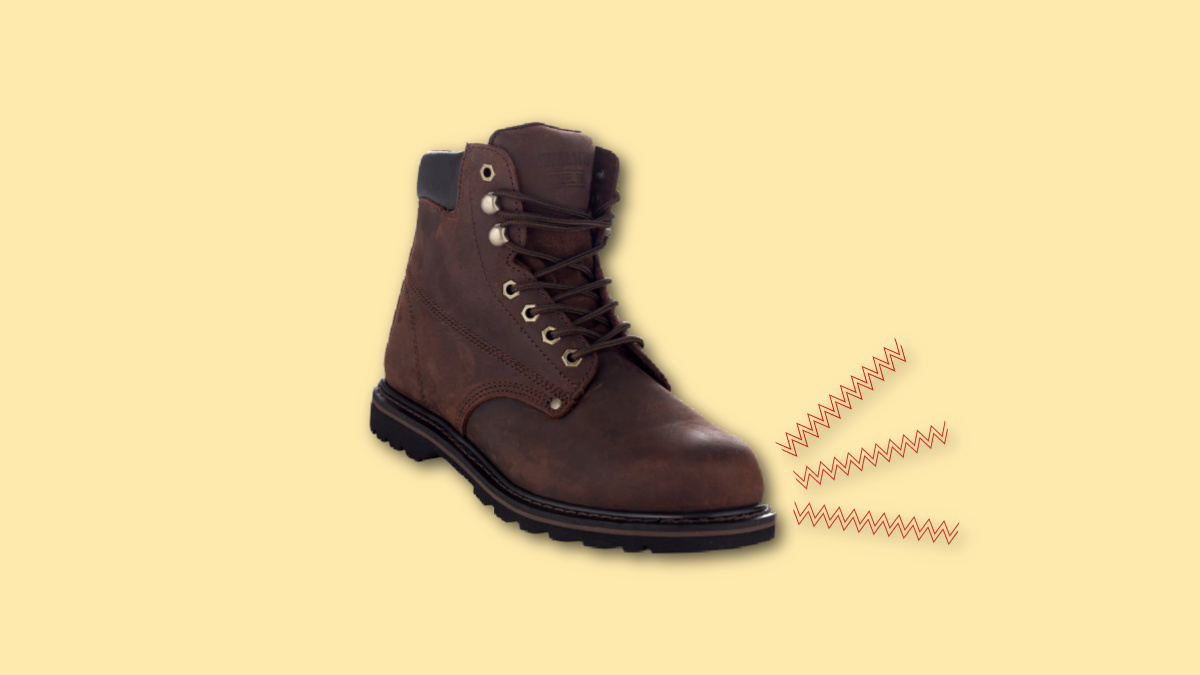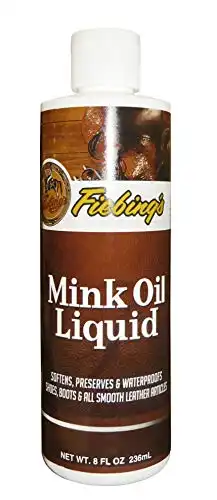Yes, they can. When you wear steel toe boots that are either improperly fitted or in excess, your feet can sustain mild to severe health problems, including ingrown nails, general heel and arch pain, blisters, corn, and more.
However, when worn properly, steel toe boots are a terrific asset that protects your feet when working in dangerous conditions.
Steel toe boots are a staple in the construction world. And it’s easy to see why: these mighty shoes protect us from punctures, flying objects, extreme weather hazards, electrical threats, and more.
That’s why protection agencies like OSHA or the US Department of Labor require laborers to strap on steel toe boots before entering work zones.
Still, these boots aren’t without their drawbacks. Many workers wonder: can steel toe boots cause foot problems?
Don’t fret! We’re here to answer all your questions so you (and your feet) are happy and healthy for years to come.
Table of Contents
Are Steel Toe Boots Bad for Your Feet?
Like anything in life, the answer depends greatly on various factors. The quick and honest answer? No, steel toe boots are not bad for your feet. In many cases, they prevent your toes and feet from work hazards, like glass shards, rogue chainsaws, or protruding rusty nails (can anyone say tetanus shot?).
Still, if you’re wearing steel toe boots that don’t fit right or if you wear them excessively, they can cause significant wear and tear on your feet, leading to health problems later down the line.
That’s because these boots are heavy. Because they’re made from steel and other heavy materials, it’s paramount that you wear shoes adequately fitted so that your weight is distributed evenly. It’s also vital that your feet aren’t cramped under the steel, as too much pressure can wreak havoc on your skin and toenails, not to mention cause general foot pain.
4 Causes of Foot Pain From Steel Toe Boots
Waking up from heel pain, leg cramps, or a sore ingrown nail in the middle of the night is never fun. What’s even worse is when you realize it’s from your work-appointed shoe.
When worn improperly, steel toe boots can cause a combination amalgam of pain and problems for your feet. Below are the top causes of foot pain from steel toe boot shoes.
Wrong Size
We get it: it’s tempting to click on Amazon and speed through the buying process so you can get back to the latest binge on Netflix. But it’s key to take your time when purchasing shoes and, if possible, to try them on in person.
Why? Working in the wrong size boot is one of the top reasons people sustain foot injuries and pain. If your shoes are too small, your boots will squeeze, pinch, and chafe your feet. While that may not seem like a problem at first, after a few months of long shifts, you’ll soon realize that constant chafing can cause open blisters, painful calluses, ingrown nails, heel pain, and more.
However, if your shoe is too large, that’s a problem, too. Not only will too large of a shoe cause blisters, but loose shoes can alter your gait and will force your body to put pressure in abnormal places, leading to long-term pain, foot and joint problems, and more.
Skip the pain: work with a professional to find the right fit for your next steel toe boots.
No Arch Support
Having a shoe with adequate arch support is vital – especially for shoes that you will use to do manual labor.
Your arch is the foundation of your foot, your motion, and your entire body. In fact, the arch transmits force from your body to the ground to move and propel you forward.
If your foot lacks proper support, you will feel a significant amount of pain. Aside from general aches and pain, a lack of arch support can also lead to injury, as you will strain your tendons and ligaments.
The moral of the story? Shell out that extra cash for proper arch support. And if you’re someone with a flat foot, consider purchasing inserts to give your feet an extra boost.
Uncomfortable Boot Material
Low-quality or uncomfortable materials are a surefire way to drastically increase the chances of sustaining foot pain or injury.
During your fit, you can feel the material on your skin. Look for leather or other materials that have adequate ventilation to ensure your feet don’t overheat and become uncomfortable.
Some boots come with drying technology like waterproof membranes to prevent your boot from becoming wet.
Not Enough Ankle Support
Adequate ankle support is paramount to having a comfortable, safe, operational set of boots.
Because work boots are so heavy, if there’s not enough ankle support, you can easily strain your calf, achilles, and arch. When trying on the boots in the store, pay special attention to the ankles and feel in the back to see if there is enough padding and support for your feet.
How Long Does It Take to Break in Steel Toe Boots?
Sure, the process of breaking in a new set of boots may be somewhat annoying, but taking time to break in your shoes rather than strapping them on and hitting the work day is important to keeping your feet healthy.
Your foot is wholly unique with its shape, curves, indentations, and more. Because the shoes were from a factory, it will take some time for the shoe to conform to the unique shape of your foot. And because steel toe boots are crafted with such rigid, sturdy materials, it can take one to three weeks to fully break in your shoe.
Looking to quicken the process? Purchase mink or leather oil to soften the leather for an expedited break-in.
Used to soften, preserve and waterproof. Also helps to prevent salt stains. Not for use on suede. Apply freely and work into leather.
It also helps to plan ahead. Keep your old boots during your day job and spend one to two hours each day wearing your new boots around the house.
Can You Stretch Out Steel Toe Boots?
Need to stretch out your new steel toe boots? No problem. There are plenty of DIY hacks that you can execute on your steel toe boot.
For example, insert sealed water bags into your boots and then put the boots in your freezer (the water will freeze and expand, stretching your shoe in the process).
Another way to stretch your steel toe boot is to purchase a boot stretcher and insert it in the boot for a few days.
Common Foot Problems Caused by Steel Toe Boots
Here are some common foot problems caused by steel toe boots, including blistering and chafing, skin breakdown, hard nails, corn, and general pain.
Blisters and Chafing
We’ve all been there: you feel a pinch on your foot, and you take off your shoe to find a sore, bloody blister on your heel.
Blisters occur when the skin rubs against the shoe material, which is why wearing a shoe that fits you is so important. Though it may be slightly counterintuitive, you can still sustain blisters when your shoes are too big. This is because when your shoes are too large, your foot will slide to one side of the shoe and continually rub up against it.
You can also get blisters when you wear the wrong socks – or by not wearing any socks at all. Make sure to buy specific steel toe boot socks to pair with your worker boots.
Skin Breakdown
When there’s too much moisture in your shoe, it can spur the growth of fungus, bacteria, and other nasty infections. Ultimately, these can lead to an array of symptoms, including the breakdown of your feets’ skin.
Thankfully, there’s an easy fix. When shopping for your next steel toe boot, buy a boot with plenty of aeration. Additionally, wear socks with natural fibers and avoid socks with materials like nylon or stockings, as these trap moisture.
Ingrown Nails
Sometimes boot wearers will complain that their nails are ingrown. This is when the nail cuts into the nailbed, often causing redness, pain, and swelling. While usually ingrown nails can resolve on their own, sometimes an ingrown nail can lead to infection.
Steel toe boots can place undue pressure on your toenails if your shoes are too small for your feet. Additionally, if your gait is altered (by an improperly fitted shoe), this can also cause you to place pressure on your toenails which can lead to ingrown nails.
Corn and Calluses
Corns are calluses on top of and between your toes, which develop when work boots are too narrow and snug. Though a corn will start off being non-painful, they can eventually cause pain. In some cases, you may have to have the corn surgically removed.
General Pain
Because these boots are so heavy, many workers complain of suffering from general foot pain. The most common areas that feel pain are the balls of your feet, your arches, your heels, or the side of your feet. That’s because there’s too much pressure being exerted on the wrong place of your shoe.
How to Treat Common Foot Problems
If you’re suffering from mild or moderate foot pain, book an appointment with your local podiatrist. While you may want to tough through it, pain is a warning sign that something is wrong, and your pain can quickly spiral into greater problems; it’s vital to nip them in the bud when pain arises.
If you notice your foot is having other problems, like bacterial infections, ingrown nails, or more, wash your feet with antibacterial soap or Epsom salts. Doing this will reduce bacterial, fungus, and clear up or prevent the growth of ingrown nails. If you have blisters, apply a clean bandage over the sore for added protection – and make sure not to pop it!
Perhaps the best way to treat your foot problems is to reexamine your boot. Is it the right fit? Are your boots too old? Are they built with quality materials? Take a hard look at your shoes and pay for new ones if it’s time to retire your current pair.
That’s A Wrap
It’s paramount to protect your feet and toes when wielding materials like axes, chainsaws or when moving and carrying heavy items. When worn properly, steel toe boots are an incredible asset to laborers working in physically-demanding conditions.
That doesn’t mean these boots don’t present their own hazards. To empower your feet with the most protection, purchase properly fitted, high-quality boots, and never wear them in excess.
FAQs
Still have questions? No worries! Here are answers to some of our most frequently asked questions regarding steel toe boots and their impact on your feet.
Is it okay to wear steel toe boots every day?
Yes! If you purchase boots that are correctly fitted and have been constructed with high-quality materials, you can certainly wear them to work every day.
However, make sure to take breaks between shifts and never wear them at home if you wear them to work. Why? Your feet need breaks from the weight of that heavy, steel shoe. And if you do start to notice the presence of pain, remove the boots and assess the problem.
Why do my feet hurt after wearing steel toe boots?
There are many potential reasons why your feet hurt after a long day of wearing steel toe boots. To start, you could be wearing the wrong size, which can spur blisters but also place unnecessary and unnatural pressure on your feet.
Can steel toe boots damage your feet?
Unfortunately, steel toe boots can damage your feet if you do not wear the proper kind. This is why it’s so critical to take your time when shopping for a new pair to ensure you’re making the correct long-term investment.



Join the Discussion